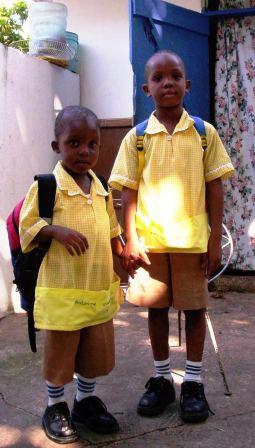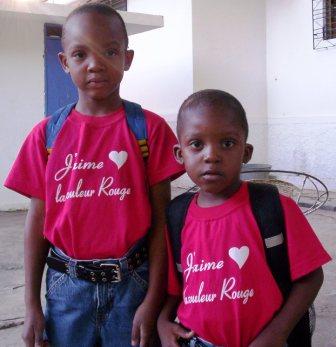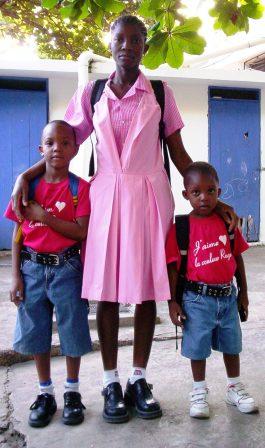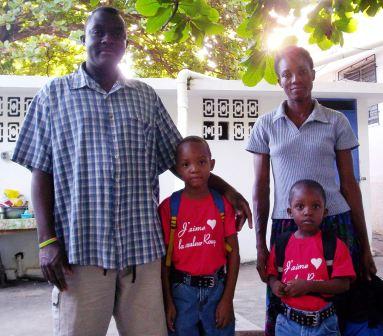I didn’t know her. As Edwa led us up to the open casket, John said to me quietly that he had never seen her alive. As I looked at the face of dead woman’s corpse, neither older or younger-looking than her 57 years, I thought to myself that I wasn’t seeing her now. She wasn’t the corpse in the coffin before me.
Edwa is a friend and also, as I learned to say in the year I spent working in a Business Office, a vendor. He drives a motorcycle-taxi, and he’s the one we call on. We have enormous confidence in him-so much so that we bought him a pager so that we could always reach him. He is reliable, trustworthy, and a great driver. He takes us around, but also runs errands and hand-delivers letters. On the back of his bike you really feel safe.
Or as safe as Pòtoprens traffic generally allows one to feel. Even sitting behind him, even with no way to watch his eyes, I am always struck by how alert he seems, by how much he seems to be paying attention to. His head is in constant but very slight motion as he turns from mirror to mirror to various spots of the road-both what’s directly in front of him and what’s farther ahead. On the roads here, more potholes than roads, he weaves so carefully that one hardly ever feels a bump. With him, there are no close calls. He is also, invariably, on time.
But he’s also a great friend, a man in his early twenties with a gentle manner, a gentle little voice and, almost uniquely among the Haitians I know, delicate soft hands. We had been following with concern the decline of his mother – “manman” in Kreyol – for several weeks. When I saw Edwa in early January, she was in the hospital. She had been diagnosed as diabetic, and they had just cut off two toes. She would, he said, be fine-able to walk within a few months. A week later, they cut off her whole foot. A week after
that, she was dead.
Monday night, Coleen, Erik, and I went to the “veye,” which is something like a wake, but even more like a block party. Edwa lives in a poor, over-crowded neighborhood of Petyonvil. It’s a lively and potentially dangerous area, where a fair amount of drug traffic is said to go on. It’s also said, however, that if you aren’t involved in that stuff, and you’re with people who live there, you’re ok. Edwa himself says, for example, that he can leave his motorcycle parked on the street all night while he sleeps in his little room, a short way up one of the side alleys. The very fact that there’s criminal business going on all night provides a certain kind of security.
We got to the veye at around 8:30 or 9:00, but the party wasn’t nearly in full swing. Edwa was running around arranging chairs and tables along the narrow, crowded street. His own place and the alley in front of it had no space for him to receive guests. Men were playing cards and dominos. Woman were chatting. Everyone was drinking. We sat with a cousin of his and shared jokes. Edwa was serving beer, soft drinks, and homemade liquors. Ginger tea and coffee would come later. For the couple of hours we were there, he hardly sat down. He was always working, or grabbing a younger relative or neighbor
to help him. I’m told the party probably went through the night.
What struck me most was the total absence of anything that looked like grief. If there was a sadness visible somewhere deep in Edwa’s large dark eyes, and I think that there was, it was a sadness half-hidden, or trying to hide, behind the smiling, welcoming face of typically extravagant Haitian hospitality.
On the other hand, grief flowed spectacularly at the funeral next afternoon. I went with Coleen and John. I’ve read about expressions of grief like the ones I witnessed there, but I had never seen or really imagined anything of the kind. There were two funerals in the church that day, and they were combined when the priest came to sing mass. But before the mass, the coffins lay open in a different corners of the building. A small brass band was playing by each. As people came in, they filed up to the coffin to pay their respects, or to get a last look. It’s hard for me to know what looking in a coffin is really for: It seems such a strange custom to me. Edwa welcomed everyone dutifully, even warmly, but without the previous night’s smile. I would have expected him to be exhausted, but he didn’t look it. He was, instead, a picture of funereal solemnity. As the occasion demanded.
And there was shrieking. Women, mostly middle-aged women, would give themselves over to spectacular, spectacular cries. Some would fall down, needing the hurried support of those around them. Some would writhe, tossing themselves about, or being tossed about, in their pain. Their companions would collect shoes they had kicked across the room or purses they had thrown aside. They would try to lift them gently into a chair.
It’s tempting to try to explain their wailing. Various accounts are possible. None seems to me much more convincing than to say that the women were overcome by a spirit which let them give themselves over to ecstasies of pain. But that could be well off the mark, and I don’t really know what those words mean anyway. After the mass, I headed up the hill towards home. John and Coleen went to the cemetery.
Edwa has problems: He lost an older sister horribly last year. He had to sell his motorcycle to pay for her funeral. He rents one now, so it’s that much harder for him to save money towards his own future. And his mother’s funeral seemed enormously expensive, too. He’s left as the oldest child, with a younger sister who’s the single mother of two and a little brother in high school. They both depend on him now. But Edwa will surely manage. He has a good job, one that he likes, and he’s very good at it. There are a lot of Haitians much worse off than he.
But I don’t want to leave things there. I’d like to add one more thing. One idiomatic way to call a person “cruel” or “pitiless” in Kreyol is to say that they are “san manman,” or “without a mother.” I’m not sure why this is so. I can imagine several explanations. And now Edwa is without a mother. Nothing would convince me that he will turn pitiless or cruel. But I would say this much: the fact that Haitians use the expression in this way might be a way of thinking about the immeasurable enormity of Edwa’s loss.




